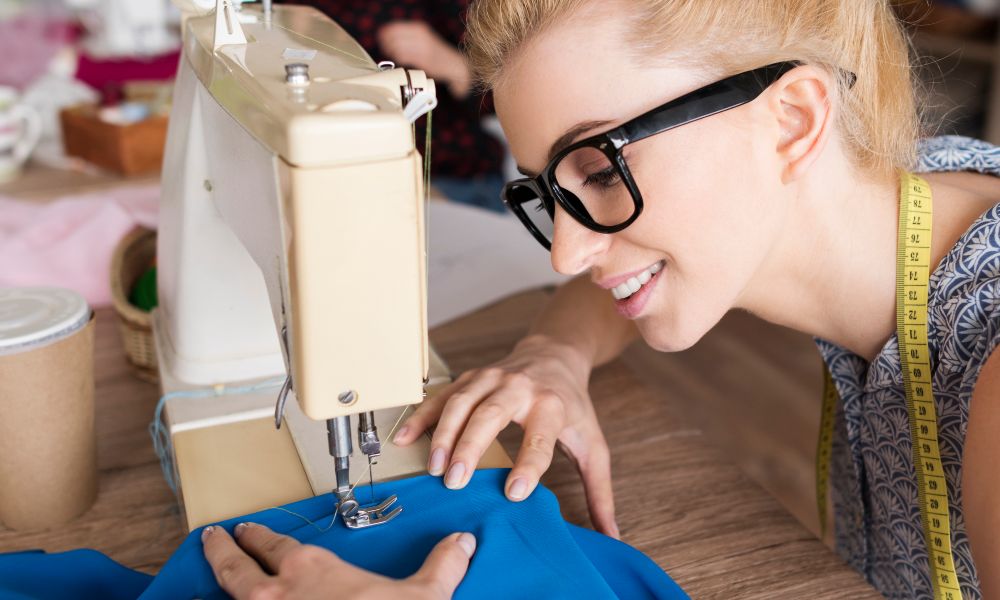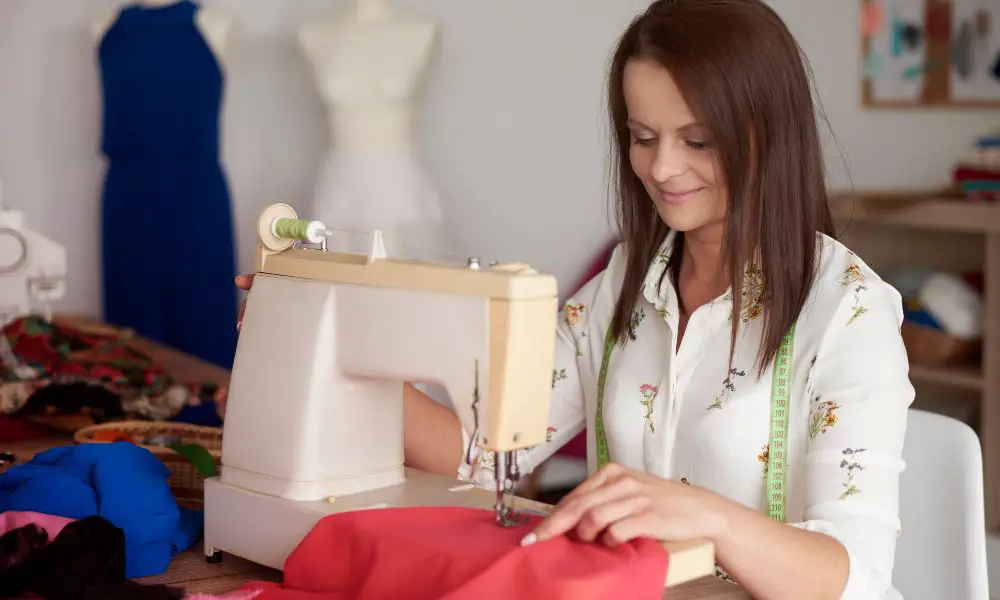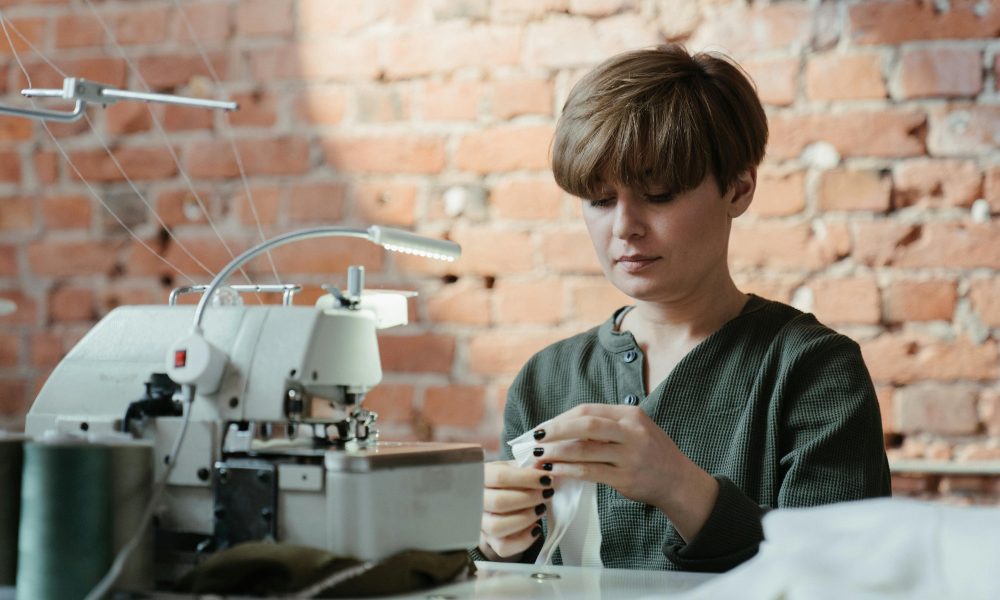Introduction: Are you captivated by creating beautiful garments or home decor pieces with your hands? Sewing is a timeless craft that combines creativity, practicality, and a touch of magic. In this comprehensive guide, we’ll unveil the secrets to embarking on your sewing journey, transforming fabric into masterpieces one stitch at a time.
Assembling Your Sewing Arsenal
As a beginner embarking on the enchanting sewing journey, you must equip yourself with the essential sewing supplies akin to a warrior’s arsenal. These tools will become your trusted companions, enabling you to conquer every project with finesse and precision.
Essential Sewing Supplies: Demystifying the Tools of the Trade
Sewing Machine: The Heart of Your Sewing Empire At the core of your sewing realm lies the sewing machine, a mechanical marvel that will breathe life into your creations. Invest in a reliable machine suited for beginners, ensuring smooth operation and consistent stitching. Explore user-friendly options from brands like Brother, Singer, or Janome, and embrace the joy of machine sewing.
Designing clothing can have advantages when using materials that are lightweight, such as cotton or linen.
Scissors and Shears: Precision Cutting Instruments Accurately cutting fabric is essential in the sewing process. Equip yourself with a pair of sharp fabric scissors designed specifically for cutting woven fabrics with ease. With their petite and precise blades, embroidery scissors will become your trusted ally when snipping threads or intricate details. Remember, never use these sacred scissors for anything other than fabric, lest you dull their cutting prowess.
Pins, Needles, and Threading Accessories Like a seasoned archer, you’ll need an assortment of pins and needles to keep your fabric layers aligned and secure. Invest in high-quality hand-sewing needles, sewing machine needles, and glass-headed pins to ensure seamless stitching and effortless fabric manipulation. Don’t forget the seam ripper, your trusty ally when mistakes happen. It allows you to gracefully undo stitches without damaging the fabric.
Measuring Tools and Marking Utensils Precision is vital in the sewing realm, and your measuring tools will be your faithful guides. A flexible tape measure, a clear ruler, and fabric marking pens or chalk will help you accurately transfer pattern pieces onto your fabric canvas, ensuring a flawless fit and impeccable construction.
Ironing Essentials for a Polished Finish A well-pressed garment or project is the hallmark of a true sewing artisan. Invest in a reliable iron and an ironing board or mat to keep your fabric smooth and wrinkle-free throughout the sewing process. Consider purchasing a tailoring ham and seam roll to press curved areas and seams effortlessly.
Mastering the Basics: A Stitch in Time Saves Nine
Before you dive into the depths of sewing, it’s essential to master the fundamental techniques that will lay the foundation for your future creations. Embrace these basics with patience and diligence, for they hold the keys to unlocking a world of sewing mastery.
Getting Acquainted with Your Sewing Machine
Threading the Machine: A Step-by-Step Guide Properly threading your sewing machine is akin to a sacred ritual, ensuring that each stitch is formed with precision and grace. Follow the manufacturer’s instructions carefully, guiding the thread through the intricate path of tension discs, take-up levers, and needles. Remember, a well-threaded machine is the first step towards sewing serenity.
Tension Adjustments: The Key to Perfect Stitches Every sewing machine has a tension mechanism that controls the tautness of the stitches. Mastering the art of tension adjustment is crucial for achieving professional-looking results. Too loose, your stitches will appear looped and sloppy; too tight, and you risk fabric puckering or thread breakage. Experiment with scrap fabric until you find the perfect balance, ensuring your stitches lie flat and evenly on both sides of the fabric.
Stitch Types and Their Applications Unlock the power of your sewing machine by exploring the various stitch types at your disposal. The humble straight stitch is a versatile workhorse, perfect for seaming, topstitching, and basting. Explore the world of zigzag stitches for secure seam finishes and decorative embellishments. Venture into buttonholes, stretch stitches, and ornamental designs, expanding your creative repertoire with each new stitch mastered.
Fabric Selection 101: Choosing the Right Canvas for Your Creation
Sewing is an art form, and just like a painter selects the perfect canvas, you must choose the appropriate fabric for your project. A good comprehension of fabric weaves, fibers, and weights will allow you to craft exceptional pieces of work that will last for a long time.
They understand Fabric Weaves and Fibers. Delve into woven fabrics, where threads intertwine to create intricate patterns and textures. Cotton, linen, and silk are natural fibers renowned for their breathability and drape, while polyester and nylon offer durability and easy care. Gaining an understanding of the distinct features of each fiber type can assist in making a knowledgeable decision when choosing the most appropriate material for your particular undertaking.
The choice of fabric weight plays a crucial role in the final result of your sewing projects. From delicate and airy lawns to robust and sturdy canvases, the suitability of each fabric weight is vital to your success. Lightweight fabrics are ideal for delicate garments like blouses and dresses, while heavier weights like denim and twill lend themselves to structured pieces like jackets and pants. Consider your project’s intended use and choose the appropriate fabric weight for optimal drape, structure, and wearability.
Pre-washing and Preparing Fabrics for Sewing Before you cut into your fabric, it’s essential to prepare it for sewing properly. Pre-washing helps shrink and set the fibers, ensuring your finished project retains its shape and size after laundering. Iron or press the fabric to remove wrinkles and creases, creating a smooth canvas for your stitches to dance upon.
First Stitches: Embark on Your Maiden Sewing Voyage

With your sewing arsenal assembled and the basics mastered, it’s time to embark on your maiden sewing voyage. Start with simple projects that will build your confidence and allow you to practice your newfound skills, one stitch at a time.
Simple Starter Projects to Build Confidence
Tote Bags and Pouches: Functional and Stylish Tote bags and pouches are the perfect starting point for any beginner sewer. These versatile projects introduce you to the basics of seaming, topstitching, and construction and provide a functional and stylish accessory to showcase your handiwork. Try various fabrics, decorations, and fastenings to design customized items that showcase your fashion sense.
Pillowcases and Napkins: Embellishing Your Living Spaces Transform your living spaces with handcrafted pillowcases and napkins, infusing them with your creative flair. These projects are ideal for practicing straight stitching, seam finishes, and precise measurement. Elevate your creations with decorative stitches, appliqués, or embroidery, adding a touch of personalization to your home decor.
Quilted Coasters or Placemats: Embracing Geometric Patterns Embrace patchwork art by creating quilted coasters or placemats. These projects introduce you to the world of quilting and challenge you to master precise cutting, seaming, and geometric pattern assembly. Experiment with various fabric combinations and quilting designs, showcasing your newfound skills in a practical and visually stunning way.
Honing Your Craft: Advancing Through the Sewing Realms
You’ll crave more advanced techniques and challenges as your sewing journey progresses. Embrace this growth by honing your craft and venturing into new realms of sewing mastery.
Pattern Reading and Alterations: Tailoring Perfection
Deciphering Sewing Pattern Instructions Sewing patterns are the blueprints that guide you through the construction of garments, home decor, and beyond. Learn to easily translate the intricate language of pattern instructions, interpreting symbols, measurements, and diagrams. Master the art of following step-by-step directions, unlocking endless possibilities.
Adjusting Patterns to Achieve the Perfect Fit Everybody is unique, and achieving a flawless fit is the hallmark of a skilled sewer. Embrace the art of pattern alterations, adjusting measurements and proportions to suit your shape. Learn to interpret ease allowances, adjust seam lines, and customize darts and gathers, transforming commercial patterns into personalized garments that flatter your form.
Seam Finishes and Edge Treatments: Polished Professionalism
Mastering professional seam finishes and edge treatments can help take your sewing projects to the next level. This will add refinement and durability to your creations, elevating them to new heights.
Overcasting, Serging, and Binding Techniques Explore the world of overcasting, a technique that secures and finishes raw fabric edges, preventing fraying and adding a polished look. Invest in a serger or overlock machine to achieve professional-grade seam finishes with speed and precision. Alternatively, master the art of bias binding, encasing raw edges with beautifully finished strips of fabric for a couture touch.
Adding Zippers, Buttons, and Embellishments
Take your sewing skills to new heights by learning to insert zippers, sew on buttons, and apply embellishments like beads, sequins, or appliqués. These finishing touches add functionality and allow you to infuse your style and creativity into every project, transforming ordinary garments into extraordinary works of wearable art.
Embracing Creativity: Unleashing Your Sewing Artistry
As you become more skilled in sewing, don’t be afraid to let your imagination run wild and delve into the endless possibilities of sewing creativity. From upcycling and repurposing to embroidery and quilting, the possibilities are limitless.
Upcycling and Repurposing:
- Breathing New Life into Old Treasures Embrace the sustainable and eco-friendly practice of upcycling by transforming discarded fabrics, clothing, or household items into unique and functional creations.
- Use your creativity to bring a fresh perspective to old possessions.
- Mix different materials and methods to make unique pieces that showcase your taste and beliefs.
Exploring Embroidery and Appliqué
You can enhance the beauty of your sewing projects by incorporating embroidery and appliqué to add personal touches. Using delicate floral motifs or bold graphic designs, you can add a personal touch and artistic flair to garments, home decor, and accessories. These techniques offer a wide range of options to make your creations unique. Explore various embroidery stitches, like the running stitch, satin stitch, or French knots, and experiment with appliqué techniques to create layered textures and dimensional elements.
Venturing into Quilting
The Art of Patchwork Storytelling Immerse yourself in the captivating world of quilting, where fabric scraps and pattern pieces come together to weave intricate stories and stunning designs. Master the art of patchwork, combining geometric shapes and vibrant colors to create heirloom quilts that are both functional and visually stunning. Explore various quilting techniques, such as piecing, appliqué, and free-motion quilting, to add depth and texture to your creations.
FAQs:
What are the essential tools I need to start sewing?
To begin your sewing journey, you’ll need a reliable sewing machine, fabric scissors, pins, needles, a seam ripper, measuring tools, marking utensils, and ironing essentials. Having these basic tools will set you up for success.
How do I choose the suitable fabric for my sewing project?
When selecting fabric, consider the project type, fabric weight, and fiber content. Using lightweight fabrics like cotton or linen can be advantageous when designing clothes. It can be beneficial to incorporate these fabrics into the design process. On the other hand, if you want to create sturdy products or home decor, it’s more suitable to use heavier materials like denim or canvas. Understand fabric weaves and fibers to make an informed choice.
How do I read and understand sewing patterns?
Reading sewing patterns can be daunting initially, but it’s a skill that can be developed. Start by familiarizing yourself with pattern symbols, measurements, and instructions. Learn to interpret ease allowances, adjust seam lines, and modify patterns to achieve the perfect fit.
What are some beginner-friendly sewing projects?
Simple projects like tote bags, pillowcases, napkins, quilted coasters, or placemats are excellent starting points for beginners. These projects allow you to practice basic techniques like seaming, topstitching, and construction while creating functional and stylish items.
How can I add personal touches to my sewing projects?
Embrace creativity by exploring embroidery, appliqué, and embellishments like beads, sequins, or decorative stitches. These techniques allow you to infuse your personality into every creation, transforming ordinary garments or home decor into unique works of art.
What are some tips for achieving professional-looking seam finishes?
To achieve polished seam finishes, master techniques like overcasting, serging, and bias binding. These methods securely encase raw fabric edges, preventing fraying and adding a couture touch to your projects. Additionally, learn to insert zippers and sew on buttons for a truly professional finish.
How can I continue developing my sewing skills?
Continuous learning is critical to advancing your sewing skills. Explore advanced techniques like pattern alterations, quilting, and couture sewing. Attend workshops, join sewing communities, and invest in instructional books or videos to expand your knowledge and creativity.
Is it necessary to take sewing classes as a beginner?
While not mandatory, sewing classes can be invaluable for beginners. Instructors can provide hands-on guidance, offer tips and tricks, and ensure you develop proper techniques from the start. Classes also offer a supportive learning environment and opportunities to connect with fellow sewing enthusiasts.
Conclusion
Sewing is a self-expression, patience, and unparalleled satisfaction journey. With each stitch, you’ll weave a tapestry of accomplishments, transforming simple fabrics into cherished creations. Embrace the thrill of the needle and thread, and let your imagination soar as you embark on this captivating adventure. What will be your first handcrafted masterpiece?
***
Main image: freepik




